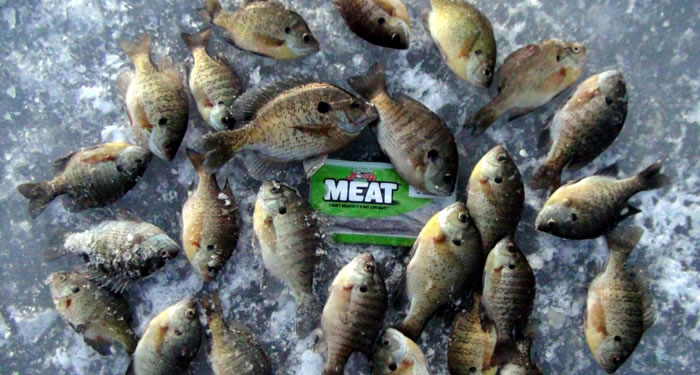Catching Suspended Negative Panfish
By David Scholfield - December 1, 2012My biggest piece of advice for anglers is simple, "don't fish until you find them." The advent of lightweight shanties, cordless drill adaptors, and advanced electronics has made finding fish easier than ever before. The technique in deeper water is simple, one angler drills and one angler follows with electronics - no need to clean the hole, just drop the transducer and see if they are there. Suspended fish can be tough to locate but understand there is a reason they are there. Perhaps it's a depression, or a small hump, or maybe even a patch of weeds, but when found these areas can consistently provide action throughout the ice season. When you mark a school, fish them hard and fast and catch "the biters." Sometimes there is only one per hole, sometimes five, but somewhere fish are feeding. I don't make jig changes or spend too much time fishing a hole that's marking fish but not producing - simply remove the "biters" and move on, either they're interested or they are not.
When jigging for suspended panfish (fish located anywhere from just below the ice to four feet off the bottom) the right equipment and setup can really make a difference. I've had great success with a medium to medium light action rod, low stretch super line, and a high quality barrel swivel and strike indicator. A medium action rod provides stiff backbone, and when used in tandem with the low stretch line, the result is quicker hook sets and therefore less missed fish. I tie the super line to a small barrel swivel with approximately eighteen inches of monofilament ice line leading to the jig. The swivel does a great job of limiting line twist and simply put, most panfish will not eat their dinner when it's spinning in circles.
Deep water greatly reduces the effectiveness of even the best traditional spring bobbers. Couple this with the fact that some fish inhale the bait and don't move, or even swim up with the jig (a negative strike), and it can be extremely difficult to detect bites. The last couple of years I've had the opportunity to fish with an EasyBite strike indicator and it has greatly improved my hookup ratio. The system uses a counter balance weight which detects all types of strikes - even negative bites. If you pursue crappie, this unit is a must because "paper lips" almost always attack from underneath and lift the bait - a strike that usually goes undetected without an Easybite. When fishing a deep school of any species, I close my bail when my jig is about four feet above the fish. This allows the Easybite to level out and then I slowly lower the rod tip to meet the fish. If I don't get any takers with this subtle approach, I will try a super aggressive jigging cadence that seems to almost irritate the fish into biting. Remember that in deeper water simply twitching the rod tip won't create much action, you must really get aggressive to ensure jig movement. Uncle Josh MEAT tipped on the jig is a good option because of its tantalizing action with even the slightest jigging motion. MEAT comes in a variety of colors, contains livebait juices, stays on the hook for numerous fish, and can easily be cut to the size and shape you prefer.
Hopefully these tips and techniques for suspended deep water panfish will help you keep a bend in your rod and the family well fed this winter!












